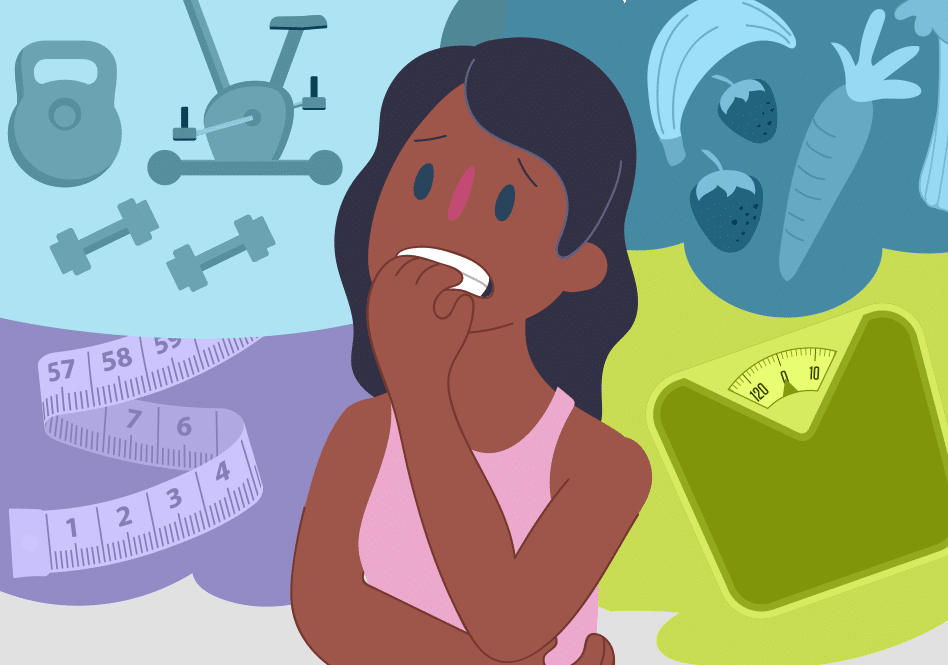Eating disorders are serious mental health conditions that affect how individuals relate to food, their body, and their overall self-image. These disorders can severely impact physical health, emotional well-being, and relationships. They are not simply about food; they are complex illnesses influenced by a variety of psychological, biological, and societal factors.
Despite growing awareness, many people with eating disorders go undiagnosed for years, leaving them vulnerable to worsening symptoms and complications. This article provides an in-depth exploration of the symptoms, types, causes, and treatments of eating disorders, along with practical tips for managing recovery and supporting loved ones.
Table: Types of Eating Disorders and Their Key Characteristics
| Type of Eating Disorder | Key Characteristics | Common Symptoms |
|---|---|---|
| Anorexia Nervosa | Intense fear of gaining weight, severe food restriction, and distorted body image. | Extreme weight loss, preoccupation with calories, sensitivity to cold, fatigue, and excessive exercise. |
| Bulimia Nervosa | Repeated episodes of binge eating followed by compensatory behaviors like vomiting or excessive exercise. | Eating large amounts of food in a short time, feelings of shame, purging, or strict dieting. |
| Binge Eating Disorder | Recurrent episodes of eating large quantities of food, often accompanied by feelings of guilt or distress. | Eating rapidly, eating when not hungry, eating in secret, and feeling uncomfortably full. |
| Avoidant Restrictive Food Intake Disorder (ARFID) | Avoidance of food due to sensory sensitivity, fear of choking, or lack of interest in eating. | Significant weight loss, nutritional deficiencies, and reliance on supplements or tube feeding. |
| Other Specified Feeding or Eating Disorder (OSFED) | Eating behaviors that cause distress or impairment but do not meet the criteria for other specific disorders. | Symptoms vary widely and may include patterns similar to anorexia, bulimia, or binge eating. |
Understanding Eating Disorders
Eating disorders often stem from deep-seated emotional challenges and distorted beliefs about body image, weight, and self-worth. They can affect anyone, regardless of age, gender, or cultural background.
In Australia, eating disorders affect nearly one million people annually, with certain groups such as women, children, and gender-diverse individuals being at higher risk. Early diagnosis and treatment are critical for better outcomes and improved quality of life.
Symptoms of Eating Disorders

The symptoms of eating disorders are wide-ranging and may present differently in each person. They are generally categorized into emotional, behavioral, and physical signs.
Common Symptoms Include:
- Fluctuations in weight, either significant loss or gain.
- Obsessive thoughts about body size, shape, or weight.
- Feelings of guilt, shame, or self-loathing about eating habits.
- Fatigue, dizziness, and sensitivity to cold.
- Social withdrawal, particularly from situations involving food.
- Anxiety, irritability, or mood swings.
- Ritualistic behaviors around food, such as cutting it into tiny pieces or eating alone.
- Binge eating or secretly hoarding food.
- Avoiding meals or making excuses not to eat.
- Trips to the bathroom after meals, often to purge.
Recognizing these symptoms early is essential to initiating treatment and preventing further complications.
Types of Eating Disorders
Eating disorders are classified based on specific patterns of disordered eating behaviors and their underlying causes. Each type requires a unique approach to treatment.
Anorexia Nervosa
Anorexia nervosa is characterized by extreme food restriction, intense fear of gaining weight, and a distorted body image. People with anorexia often perceive themselves as overweight, even when they are dangerously underweight.
Symptoms of anorexia nervosa include:
- Severe calorie restriction and avoidance of entire food groups.
- Extreme weight loss and refusal to maintain a healthy body weight.
- Physical symptoms such as thinning hair, brittle nails, and loss of menstrual cycles.
- Excessive exercise, even when physically unwell.
Bulimia Nervosa
Bulimia involves cycles of binge eating followed by compensatory behaviors to prevent weight gain, such as purging, fasting, or excessive exercise. Unlike anorexia, individuals with bulimia often maintain a normal weight.
Symptoms of bulimia nervosa include:
- Episodes of consuming large amounts of food in a short time.
- Feelings of loss of control during binge episodes.
- Use of laxatives, diuretics, or vomiting to counteract overeating.
- Physical signs such as swollen cheeks, tooth decay, or acid reflux.
Binge Eating Disorder (BED)
BED is characterized by recurrent episodes of consuming excessive food without compensatory behaviors. It is often accompanied by feelings of guilt, shame, and distress.
Symptoms of binge eating disorder include:
- Eating unusually large amounts of food in one sitting.
- Eating quickly, often to the point of discomfort.
- Consuming food when not hungry or as a way to cope with emotions.
- Feelings of embarrassment or guilt about eating habits.
Other Specified Feeding or Eating Disorder (OSFED)
OSFED encompasses disordered eating behaviors that cause significant distress but do not meet the full criteria for anorexia, bulimia, or BED.
Avoidant Restrictive Food Intake Disorder (ARFID)
ARFID involves restrictive eating behaviors unrelated to body image concerns. People with ARFID may avoid foods due to sensory sensitivities, fear of choking, or a lack of interest in eating.
Symptoms of ARFID include:
- Avoiding specific food textures, smells, or appearances.
- Failing to meet nutritional or energy needs.
- Significant weight loss or growth delays in children.
Causes of Eating Disorders
Eating disorders are complex and multifaceted, with no single cause. Instead, a combination of biological, psychological, and social factors contributes to their development.
Social Factors:
- Unrealistic beauty standards and societal emphasis on thinness.
- Normalization of dieting and weight loss as markers of success.
- Pressure from peers, media, or certain professions, such as modeling or athletics.
- Major life transitions, such as starting a new job, moving to a new school, or experiencing the loss of a loved one.
Biological Factors:
- Genetic predisposition to eating disorders or mental health conditions.
- Physical changes during adolescence, including hormonal shifts.
- Family history of eating disorders or related conditions.
Psychological Factors:
- Low self-esteem or negative body image.
- Perfectionist tendencies or fear of failure.
- Difficulty coping with stress, anxiety, or trauma.
- Obsessive-compulsive tendencies or impulsive behaviors.
Treatment and Recovery
Treatment for eating disorders often involves a multidisciplinary approach, including medical, nutritional, and psychological care. Recovery is a highly individual process, but with the right support, it is achievable.
Common Treatment Options:
- Psychotherapy: Cognitive-behavioral therapy (CBT) helps individuals identify and change harmful thought patterns and behaviors. Family-based therapy is especially effective for adolescents.
- Nutritional Counseling: A registered dietitian helps individuals rebuild healthy eating habits and understand their nutritional needs.
- Medication: Antidepressants or anti-anxiety medications may be prescribed to address co-occurring mental health issues.
- Medical Monitoring: Regular checkups are essential to address physical complications, such as malnutrition or heart problems.
Tips for Managing Recovery
- Seek Professional Help Early: Early diagnosis and treatment improve outcomes.
- Set Realistic Goals: Focus on small, achievable milestones to build confidence.
- Practice Self-Compassion: Avoid self-criticism and celebrate progress, no matter how small.
- Avoid Triggering Situations: Limit exposure to media or environments that promote unhealthy body ideals.
- Build a Support Network: Surround yourself with trusted friends, family, or support groups.
- Develop Coping Strategies: Engage in stress-reducing activities like yoga, journaling, or mindfulness.
Supporting Someone with an Eating Disorder
Supporting a loved one with an eating disorder can be challenging, but patience and understanding are crucial.
- Educate yourself about eating disorders to better understand their experiences.
- Use non-judgmental language and avoid commenting on their weight or appearance.
- Express your concerns gently, focusing on specific behaviors rather than their physical appearance.
- Encourage them to seek professional help and offer to accompany them to appointments.
- Take care of your own emotional well-being to ensure you can provide consistent support.
Authentic US Sources for Further Information
National Eating Disorders Association (NEDA): www.nationaleatingdisorders.org
Academy for Eating Disorders (AED): www.aedweb.org
Eating Disorders Coalition for Research, Policy & Action: www.eatingdisorderscoalition.org
National Alliance for Eating Disorders: www.allianceforeatingdisorders.com
Office of Disease Prevention and Health Promotion: www.health.gov
Conclusion
Eating disorders are serious but treatable mental health conditions. By understanding their symptoms, causes, and treatments, individuals and their loved ones can take the necessary steps toward recovery. The journey to healing is different for everyone, but with professional care, self-compassion, and a strong support system, recovery is possible.
If you or someone you know is struggling with an eating disorder, don’t hesitate to seek help. Remember, early intervention is key, and resources are available to guide you toward recovery.


